White tulips: description, varieties and cultivation

Tulips deservedly enjoy the love of many flower growers and owners of personal plots. This plant has a wide species diversity, unpretentious care and attractive appearance. White flowers of this type look especially delicate and unusual, which is why they are so popular in landscape design.

Peculiarities
The white tulip is a perennial bulbous representative of the flora, belongs to the Liliaceae family. In height, the flower can reach from 10 cm to 1 meter. The root system looks like root appendages, which are formed from the bottom of the bulb and die off annually. The stems of the white tulip are erect, cylindrical in shape. The foliage is covered with a waxy bloom, so its color is not completely green, but slightly bluish. The leaves are characterized by an elongated shape, their arrangement on the stem is alternate. At the end of the upper leaflet, a flower is formed. Tulips with white color have a lot of shades ranging from snowy white to milky. Also, the color of the buds often contains all kinds of stains of various colors or borders on the tips of the petals in yellow, pink, green.

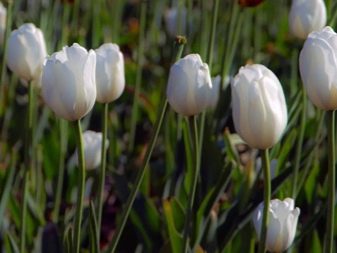
The fruits of this plant are a rounded triangular box, inside which are egg-shaped seeds. When the latter ripen, they fall off and scatter in the wind.
Varieties
The white tulip is a very popular flower; a large number of its varieties are known. Each of the growers can choose for themselves a late or early variety, with large or small flowers, classic or multi-colored type. The color of this plant is not only monochromatic, but also white-red, white-yellow, with purple stains and other variations.

Antarctica
"Antarctica" is a universal representative of white tulips, it can be used both in works related to landscape design, and for forcing, cuttings. The snow-white flower is medium-flowering, its goblet shape is a classic. The height of the flower reaches 7 centimeters, and its diameter is 5 centimeters. The culture can reach a height of 60 centimeters. Antarctica blooms from April to May.
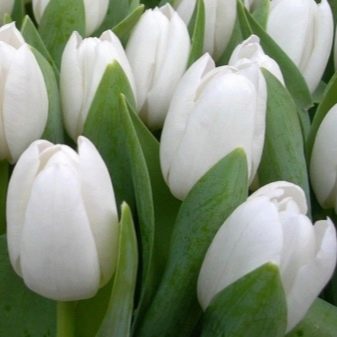
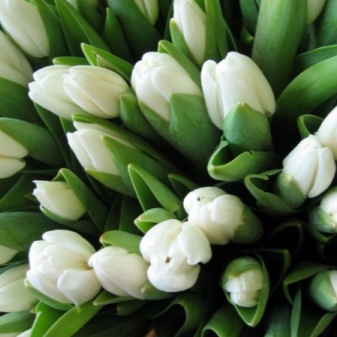
When grown in open ground, the petals of the plant may have a yellowish back. This variety is in good demand among professional flower growers, as well as among amateur buyers.
Carnaval de Nice
The variety "Carnival of Nice" is able to amaze with its beauty. The plant is late flowering and looks like a double early tulip. The flowers are red-white, are densely doubled and resemble peonies. The tulip is fragrant, and its external effect is created by combining light and bright shades that harmonize perfectly. The core of the flower is usually yellow. Each flower contains about 20 petals, which in a span reach a diameter of 10 cm. The height of the tulip is 0.45 meters, the peduncles are strong, the flowering phase is different in duration. Carnival of Nice is considered the ideal cut variety. To achieve the maximum effect when growing, it should be planted in a group way.


Daytona
Tulips of this variety are fringed, they bloom in the second half of May. The bud has the shape of a goblet type, it is large and reaches 0.1 meters in diameter. The petals are characterized by a sharp needle-like border, it is painted in a delicate white shade, sometimes turning into beige.
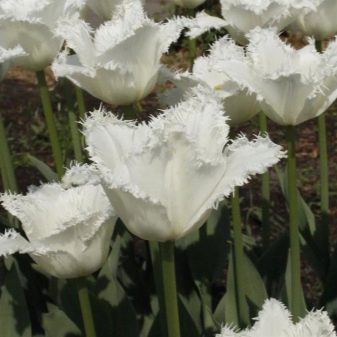
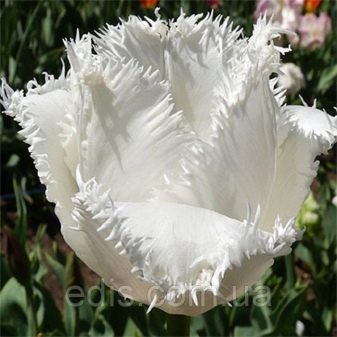
Agrass White
This variety is characterized by large classic flowers, they are elongated in shape and have sharp edges. The color of the bud is milky white, but differs from others by the presence of a green stripe on the back. The bud is goblet, 6-10 centimeters high, 5 centimeters in diameter. The plant reaches a height of 0.5 meters. It grows well and multiplies quickly, which contributes to excellent forcing. The variety begins to bloom in the second half of April and the first week of May.
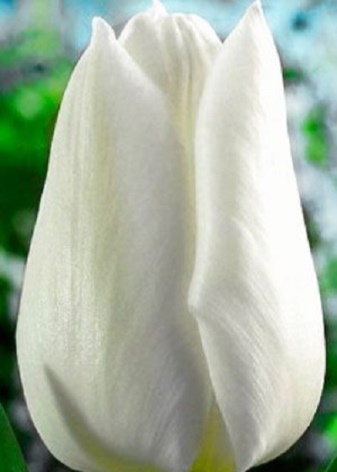
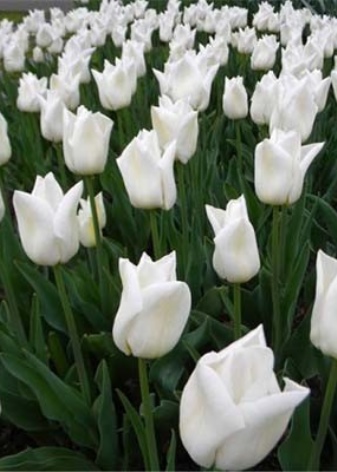
Smirnoff
Smirnoff tulips look like large white goblet buds up to 0.09 meters high. These flowers are characterized by a needle-like fringe along the edges of the petals. The plant can grow in height from 0.4 to 0.6 meters. The plant blooms in May, it perfectly decorates flower beds, while creating the appearance of a white delicate cloud.
This variety is often used for cutting.
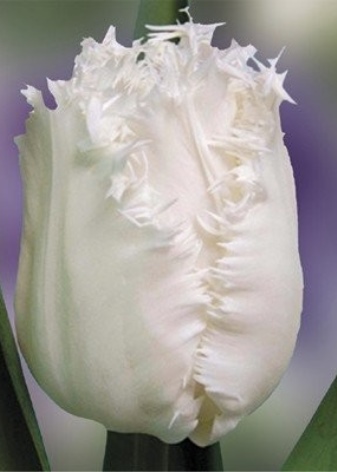
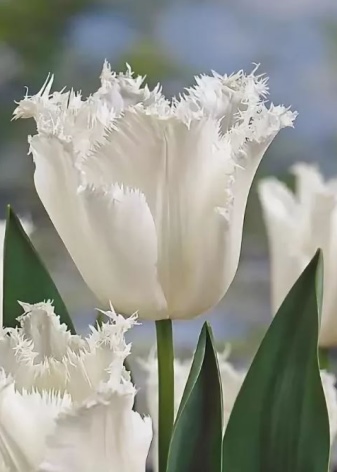
Effeyer
The flowering period of tulips of this variety falls on the first days of May. The flower can grow up to 60 centimeters. The buds are goblet, up to 0.07 meters in height, 0.04 m in diameter. The petals are white with an original purple border.

Snow lady
This tulip variety is characterized by high height, strength, slenderness. The buds of this plant are large, they have a goblet shape and a pure white color. A flower grows up to 0.6 meters, and its bud - up to 0.07 meters. Snow Lady leaves are compact, do not decay. The variety showed itself perfectly during forcing. The disadvantage of this tulip is its rather large cost and scarcity.
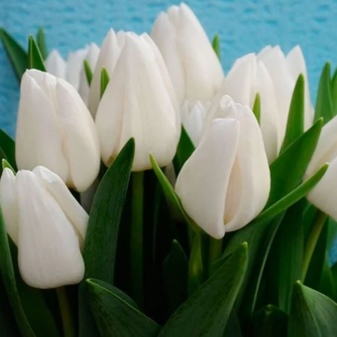

Growing conditions
Optimum growing conditions are very important for white tulips. The place of their growth should be well lit and hidden from the draft. The most suitable soil for a plant is moist, loose and fertile, which has a neutral or alkaline reaction. In bright light, tulips grow well, and their buds are characterized by large sizes and a long flowering period. The tulip feels good when the air humidity does not exceed 80%.
Excessive humidity contributes to the occurrence of various diseases.
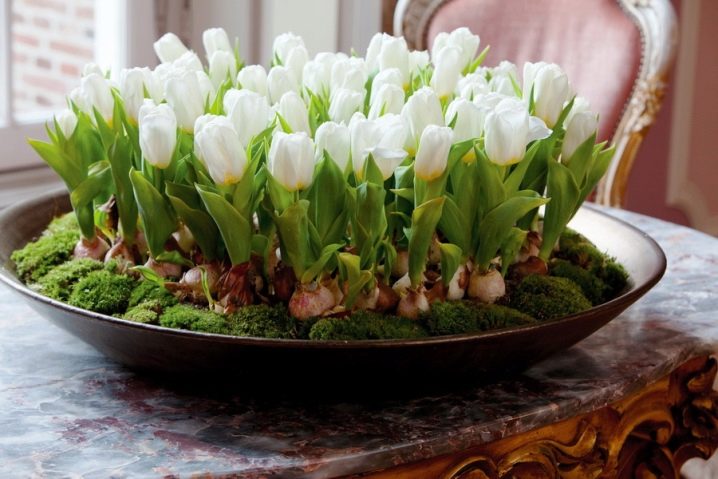
Landing
White tulips can be planted both in autumn and spring. If you want to get flowers with early and long flowering, it is recommended to plant the plant in autumn, in late September-early October. Do not forget that the soil for planting must be completely warmed up. The optimum temperature for the landing procedure is 7 degrees Celsius. The flower grower should remember that before the onset of frost, the tulip bulb must take root, for this it will take 3-4 weeks. For planting a flower, you should choose only high-quality planting material; large and healthy bulbs should be preferred. Seedlings must be treated with a weak solution of potassium permanganate or an anti-fungal preparation. The soil is dug up and fertilized in advance.
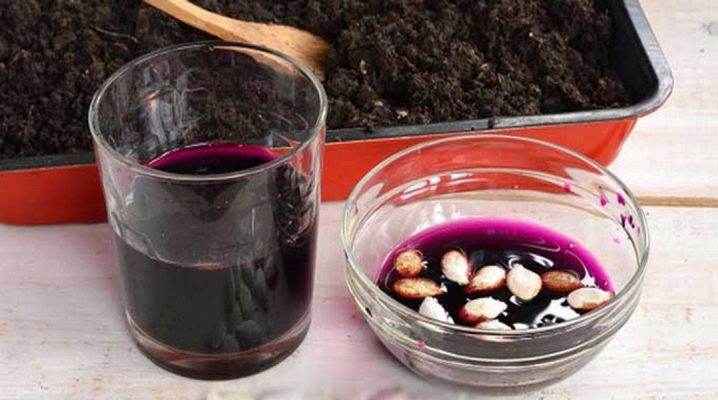
Early flowering tulips should be planted first, and late flowering tulips after several weeks. The correct planting depth is 3 bulb sizes. This figure is approximately 0.15 cm. If the substrate is heavy, then the depth should be made 2 cm less. Planting planting material should be carried out one at a time, keeping a distance between plants of 10 cm. The row spacing should not be less than 0.2 meters.
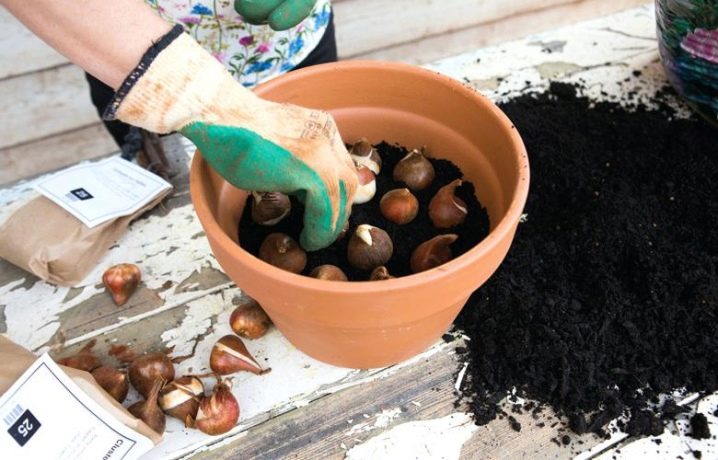
The nutrient area is directly influenced by the size of the flower bulb. The smaller it is, the closer the fit should be to each other. The smallest specimens are planted in furrows. A two-centimeter sand layer is usually poured onto the bottom of the furrows. So that the decorative qualities of the plant do not suffer, before the onset of the frosty period, it is necessary to mulch with peat, compost, and dry foliage. When spring comes, the mulch can be removed.
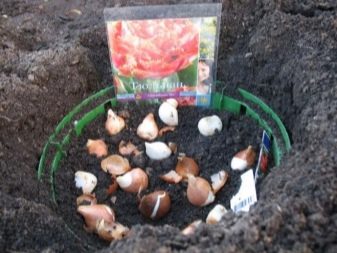

Care
It is necessary to take care of white tulips in a timely manner, this is the only way to grow a healthy, beautiful plant. In the spring, the flower needs the following care measures:
- inspection of the tulip;
- elimination of unhealthy bulbs or those that have not sprouted;
- weeding and removal of weeds;
- top dressing;
- loosening the soil;
- irrigation;
- elimination of parasites.


In order to maintain the required moisture content, which contributes to the correct growth and development of the plant, watering should be carried out as the soil dries out.
For a one-time watering of one m2 of white tulip plantations, 2 liters of warm water will be enough. According to the advice of experienced gardeners, on a plantation with tulips, it is worth organizing a shallow groove with which to irrigate. This procedure helps to moisten the soil without harming the plants. At the end of the watering procedure, it is necessary to loosen the soil and weed out the weeds. When the flowering period ends, it is worth stopping the irrigation of the white tulip, and also removing the fallen leaves.
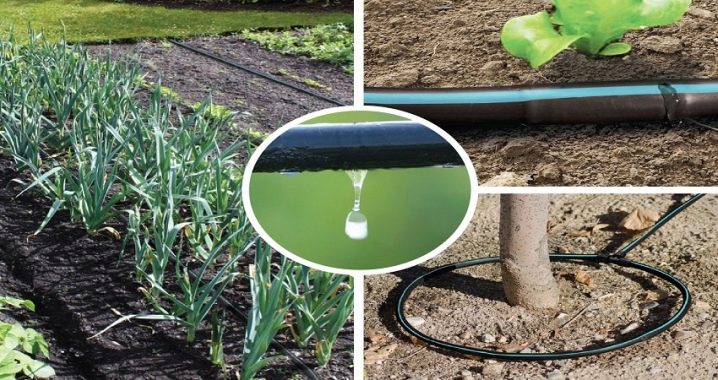
Pruning and digging out the bulbs should be done 14-28 days after the end of flowering. Only those leaves that have wilted are required to be cut. It is not worth pruning early, as such a procedure can prevent active storage of nutrients. In order to prevent damage to the bulbs during digging, you need to make the appropriate marking of their locations. It is necessary to dig out an onion that is fully ripe and has a brown spot of scales, as well as a formed root system. After that, the bulbs should be dried and stored in a dry place where the temperature does not drop below 17 degrees Celsius.

Tulips need feeding three times a day, namely in the first days of spring, during the formation of buds and the active phase of flowering. Fertilizer can be of organic and mineral origin:
- in the spring - fertilizing containing nitrogen;
- with budding - with phosphorus and potassium;
- at flowering - potash.
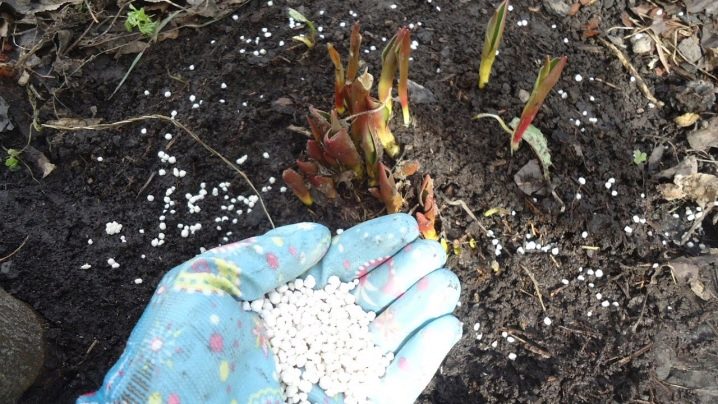
A white tulip can suffer from infectious diseases and parasite attacks. They can occur in case of unfavorable agro-technological and climatic situations, for example, high or low temperatures, mechanical damage. To protect the flower from fusarium, bacterial rot, rust, before planting a tulip, it is necessary to treat it with Bordeaux liquid. A white tulip can be attacked by an onion tick, bear, May beetle, scoop. To eliminate parasites, you need to spray the flower with the preparations "Fundazol" or "Karbofos".

For information on how to properly care for tulips, see the next video.







































































































The comment was sent successfully.